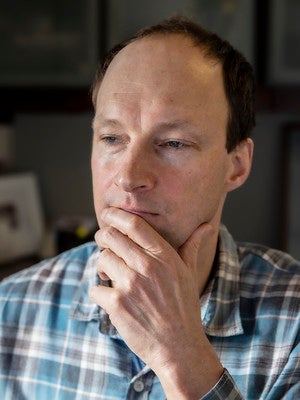In Conversation
‘Wiped out forever’ — the ecological impact of Australia’s wildfires

Kangaroos graze in a field as smoke shrouds the Australian capital of Canberra, Australia, Wednesday, Jan. 1, 2020. (Photo credit: Mark Baker, Associated Press)
The devastating wildfires rampaging through Australia since September have burned an estimated 25.5 million acres, according to news reports. Ecologists say the loss of life and habitat have been especially severe for indigenous species of animals and plants.
An estimated 1 billion animals have died in the fires.
Walter Jetz, professor of ecology and evolutionary biology and co-director of the Max Planck-Yale Center for Biodiversity Movement and Global Change, spoke with us about the ongoing ecological disaster in Australia.

What is the potential for species diversity loss due to the fires?
Scientists agree that the local population losses will be immense, and probably on a scale unmatched by any single event in the past hundred years and beyond.
While some of the species may eventually rebound and recolonize areas that are impacted now, the most troublesome news may not be the local extinctions, but rather the potential global extinctions. The affected regions in Australia are home to many species that do not occur anywhere else in the world.
Leaked government reports suggest that for over half a dozen well-studied species, such as birds, frogs, and fish, over 50% of the global population — and in some cases 100% of their habitat — may be lost.
Do we know much yet about what this will mean for the animals and plant species that survive the devastation?
They will be faced with dramatically reduced habitats and lack of food. A large, maybe the greatest, portion of the losses will not be from the fires directly but from the altered ecological conditions following the disastrous burns.
When there is an environmental catastrophe of this scale, how do researchers assess the impact for native species?
The most critical input is baseline knowledge on the spatial distribution of populations. This is the sort of information that in Australia has been extensively collected through agency-driven and research-driven monitoring.
In other parts of the world, efforts such as the Yale-based Map of Life aim to help provide this sort of information at increasingly high resolution. But even in the well-studied Australian states of Victoria and New South Wales, data gaps impede a thorough assessment, especially for smaller species. We have no idea how many species of invertebrates or plants may have already been wiped out forever by these fires.
What information and resources will policymakers and conservationists in Australia need in order to make decisions once the fires are out?
New survey campaigns supported by aerial- and satellite-based remote sensing should help in assessing the recovery of habitats and species. Hopefully, vital lessons will be learned about the importance of forward-looking research and monitoring to support a stronger evidence base for pre- and post-disaster management.
Are there efforts underway by the international academic community to help with this?
My Australian colleagues are shell shocked by the ongoing devastation and are trying to do their best in using past surveys and research to answer the most urgent questions about population losses. The Australian research community has pioneered and continues to lead some of the key scientific assessment approaches for spatial biodiversity. At the moment, I am not aware of organized international efforts, but I expect collaborations to form quickly to both add capacity to the work in Australia and to take larger lessons for societally relevant biodiversity research in a world in which such disasters will occur with greater and greater frequency.
Related
Media Contact
Fred Mamoun: fred.mamoun@yale.edu, 203-436-2643